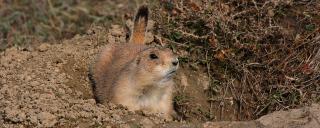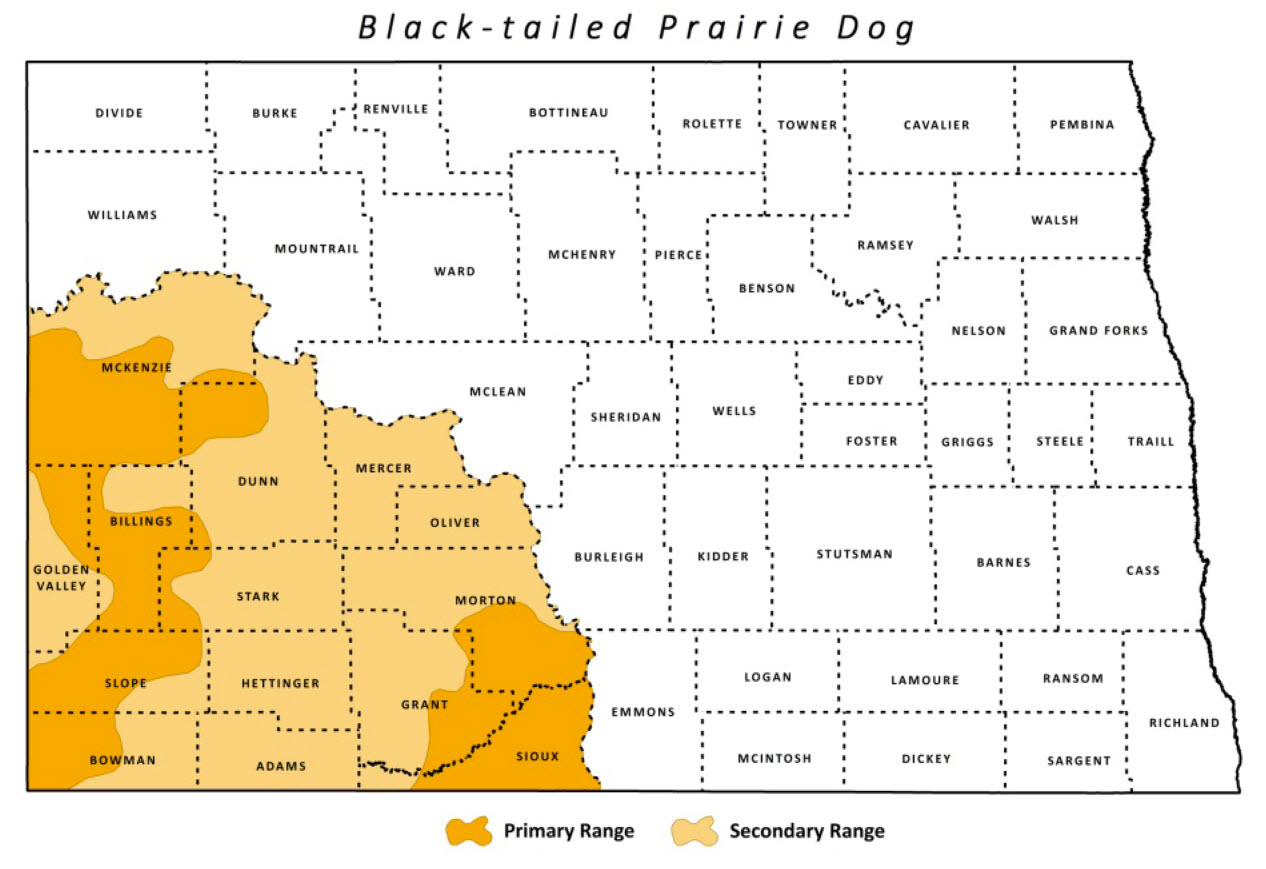
Black-tailed Prairie Dog
| Scientific Name | Cynomys ludovicianus |
|---|---|
| General Description | North Dakota’s largest ground squirrel, it is yellowish tan on its back and lighter on the belly. It has a short tail with a black tip. Found in colonies of many individuals. |
| Status | Year-round resident. |
| Abundance | Locally Common. |
| Primary Habitat | Short and mixed grasslands, usually well grazed lands. |
| Federal Status | No federal status. |
| Reason for Designation | Black-tailed Prairie Dog habitat has been reduced to 1% of its historic amount. The combination of grassland conversion and concentrated poisoning are the main causes of their population decline. Numerous grassland species depend on Black-tailed Prairie Dogs for habitat and food, including other species of conservation priority such as Burrowing Owl and Ferruginous Hawk. |
Locations and Conditions of Key Habitat
Preferred Habitat
Black-tailed Prairie Dogs are confined to prairie communities with short vegetation and relatively flat topography. They are often found in relation to areas grazed by livestock. Black-tailed Prairie Dogs live in large colonies known as “towns.”
Key Areas and Conditions for Black-tailed Prairie Dog in North Dakota
Black-tailed Prairie Dogs occur in two distinct population complexes in ND; the Little Missouri National Grasslands complex and the Standing Rock complex which includes Sioux County and portions of Grant and Morton Counties.
Problems Which May Affect this Species
Habitat
Loss of suitable Black-tailed Prairie Dog habitat is a major problem. Habitat loss is attributed to conversion of grassland to agricultural land. Historically, Black-tailed Prairie Dog range encompassed 12 million acres, of which 10% was occupied at any one time. The most recent survey estimated the North Dakota has roughly 20,000 acres.
Other Natural or Manmade Factors
Poisoning of Black-tailed Prairie Dog colonies has resulted in loss of population. Poisoning is legal on private land in North Dakota. Many types of poisons are used, but zinc phosphide and Rosal are the most common.
Research and Survey Efforts
Current Research or Surveys
- Black-tailed Prairie Dog colonies are surveyed every six years by the North Dakota Game and Fish Department to estimated population status.
- The U. S. Forest Service Dakota Prairie Grasslands office conducts surveys every three years on Forest Service land in its region.
- Theodore Roosevelt National Park surveys towns within their lands yearly.
Previous Research or Surveys
- The North Dakota Game and Fish Department surveyed nonfederal lands in 2006 and 2012.
- Reid documented the distribution of Black-tailed Prairie Dogs in southwestern North Dakota in 1954.
- A status of the Black-tailed Prairie Dog and Black-footed Ferret was conducted by Grondahl in 1973.
- Bishop and Culbertson studied prairie dog town declines in southwestern North Dakota in 1976.
- John Sidle conducted aerial surveys in 2001 to estimate acreages in North Dakota.
- A Black-tailed Prairie Dog population viability assessment was performed by Knowles in 2001.
- Knowles also completed a status of the Black-tailed Prairie Dog in 2003.
- Black-tailed Prairie Dog colony expansion was studied by Milne in 2002-03.
Additional Research or Surveys Needed
- Evaluate changes in distribution and population densities at sites prior to, during, and after oil and gas development.
- Determine the effects of fragmentation and development of barriers due to urbanization and agricultural development on dispersal and maintenance of colonies.
- Determine the effects of timing and intensity of grazing regimes on the use of habitats by BTPDs.
- Investigate the presence of sylvatic plague in North Dakota colonies.
Management Recommendations
- Work with private landowners to develop grazing management practices that consider the season, duration, distribution, frequency, and intensity of grazing use on areas to maintain vegetation on both upland and riparian sites.
- Where appropriate, incorporate the use of mechanical, chemical, and biological methods of weed control to manage noxious weeds.
- Work with private landowner to incorporate prescribed land treatments into livestock management practices to develop sustainability of biological diversity.
- Monitor the effects of shooting. The NDGFD has the authority to place restrictions on shooting if necessary.
Monitoring Plans
The North Dakota Game and Fish Department will work towards implementing a new survey technique using NAIP imagery. This methodology will be used by all 13 states in the range of the Black-tailed Prairie Dog. This standardization will allow for better data for range wide assessments of population.
2005-2015 Progress
The Black-tailed Prairie Dog continues to be a Level I Species of Conservation Priority. Population has held steady at roughly 20,000 acres. The addition and loss of small “towns” appears common. The NDGFD is working toward a standardized method of survey used by all states in the Black-tailed Prairie Dogs range.

Note: A listing of works consulted when compiling the information on this page may be found in the 2015 State Wildlife Action Plan.
